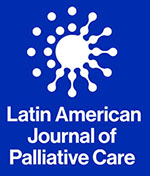Use of opioids by patients in oncology palliative care
analysis of consumption rates at a public hospital in Brasília (DF), Brazil
DOI:
https://doi.org/10.59679/LAPC20220036Keywords:
Opioid, Analgesics, Palliative Care, Medical Oncology, Hospitals, Public, BrazilAbstract
Introduction: Pain is the most common symptom in oncology, affecting more than 80% of patients, with opioids being the drugs of choice for the treatment of moderate to severe pain, especially in cancer.
Objective: To analyze the patterns of opioid consumption among a group of cancer patients presenting to a tertiary palliative care unit.
Methods: Cross-sectional study of analysis of medical records and prescriptions of patients at the Oncological PCU of a public hospital in Brasília (DF), Brazil, between September 2021 and March 2022. Fisher’s exact test was used, followed by Bonferroni’s post hoc test for categorical variables, and Kendall’s tau correlation coefficient for continuous variables.
Results: Study participants were on average 62 years old (SD ± 14.8), 52% were female and had a diagnosis of malignant neoplasms of the digestive system (40.9%), the genital system (27.6%), and others malignant neoplasms (31.5%). Participants were hospitalized for an average of 12.5 days (SD ± 18.7), most of them were using an opioid, with morphine being the most prevalent (81.9%), and drugs were delivered mostly through intravenous route (45.7%). There was a change in the routes of drug administration in 39.4% of the cases. Genital system neoplasms affected women the most.
Conclusion: In regard to the use of opioids and pain control data collected at the studied OPCU were consistent with the recommended practices of PC, such as dose rotation and titration. The patients’ profile partially matches what is expected from the epidemiology of cancer in Brazil.
References
World Health Organization (WHO). Planning and implementing palliative care services: A guide for programme managers. Geneva (CH): WHO; 2016. https://apps.who.int/iris/handle/10665/250584
Carvalho RT, Parsons HA (ed.) Manual de Cuidados Paliativos ANCP. 2nd ed. São Paulo(BR): ANCP; 2012. http://biblioteca. cofen.gov.br/wp-content/uploads/2017/05/manual-de-cuidadospaliativos-ancp.pdf
Raja SN, Carr DB, Cohen M, Finnerup NB, Flor H, Gibson S, et al. The revised International Association for the Study of Pain definition of pain: concepts, challenges, and compromises. Pain. 2020;161(9):1976-82. https://doi.org/10.1097/j.pain.0000000000001939
Castro MCF, Fuly PSC, Santos MLSC, Chagas MC. Total pain and comfort theory: implications in the care to patients in oncology palliative care. Rev Gaucha Enferm. 2021;42:e20200311. https://doi.org/10.1590/1983-1447.2021.20200311
World Health Organization (WHO). WHO guidelines for the pharmacological and radiotherapeutic management of cancer pain in adults and adolescents. Geneva(CH): WHO; 2018. https://www.who.int/publications/i/item/9789241550390
Ferreira GD, Mendonça GN. Cuidados Paliativos: Guia de Bolso. São Paulo(BR): ANCP, 2017.
Wiermann EG, Diz MD, Caponero R, Lages PS, Araujo CZ, Bettega RT et al. Consenso brasileiro sobre manejo da dor relacionada ao câncer. Rev Bras Oncol Clin. 2014 Oct;10(38):132-43.
INCA. Brasil – Estimativa dos casos novos. Estimativas para o ano de 2023 [Internet]. Instituto Nacional do Câncer; 2022 [cited 2022 Dec 02]. https://www.gov.br/inca/pt-br/assuntos/cancer/numeros/estimativa/estado-capital/brasil
Pedro A, Silva MP. Manual de rotação de opióides. 3nd ed. Lisboa(PT): Laboratórios Vitória; 2017.
Duthey B, Scholten W. Adequacy of opioid analgesic consumption at country, global, and regional levels in 2010, its relationship with development level, and changes compared with 2006. J Pain Symptom Manage. 2014 Feb;47(2):283-97. https://doi.org/10.1016/j.jpainsymman.2013.03.015.
Zoccoli TLV, Ribeiro GN, Fonseca FN, Ferrer CN (ed.). Desmistificando cuidados paliativos. Um olhar multidisciplinar. Brasília(BR): Oxigênio; 2019.
Finkelstein EA, Bhadelia A, Goh C, Baid D, Singh R, Bhatnagar S, Connor SR. Cross Country Comparison of Expert Assessments of the Quality of Death and Dying 2021. J Pain Symptom Manage. 2022 Apr;63(4):e419-e429. https://doi.org/10.1016/j.jpainsymman.2021.12.015.
Minson FP, Garcia JBS, Oliveira Júnior JO, Siqueira JTT, Jales Júnior LH (ed.). II Consenso Nacional de Dor Oncológica. São Paulo(SP): EPM – Editora de Projetos; 2011. https://www.assaeam.com.br/wa_files/livro_2consenso_nac_dor_oncologica.pdf
Lanzillotti PF. Sistemas para liberação modificada de fármacos. Rio de Janeiro(BR): Fundação Oswaldo Cruz; 2012.
INCA. São Paulo: Brasil. Câncer. Números de câncer. Estimativa – Síntese de Resultados e Comentários [Internet]. Instituto Nacional do Câncer; 2023 [cited 2023 Mar 02]. Available from: https://www.gov.br/inca/pt-br/assuntos/cancer/numeros/estimativa/sintese-de-resultados-e-comentarios/
Downloads
Published
Versions
- 2023-12-28 (2)
- 2023-10-19 (1)
Issue
Section
License
Copyright (c) 2023 Latin American Journal of Palliative Care

This work is licensed under a Creative Commons Attribution 4.0 International License.



